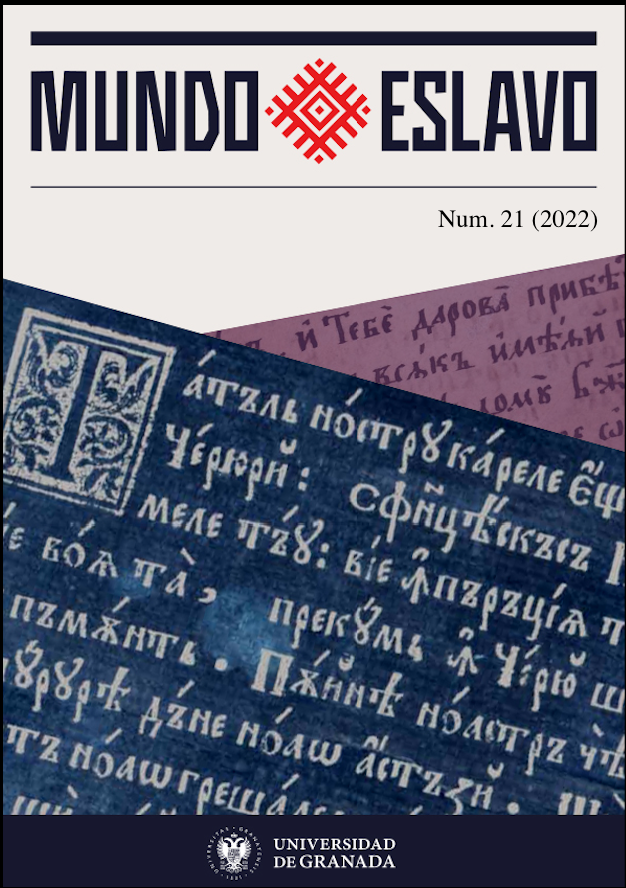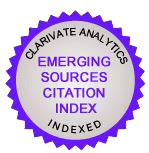Hacia un black metal postsatánico: La deconstrucción del binario divino/demoníaco en Litourgiya de Batushka
DOI:
https://doi.org/10.30827/meslav.vi21.25165Resumen
El presente artículo realiza un análisis del álbum Litourgiya (2015) de la banda polaca de black metal Batushka (estilizada comercialmente como Батюшка). El estudio se centra en el acercamiento espiritual de la banda a la cuestión del satanismo, la cual ha permeado la historia de este subgénero de metal desde sus inicios. Tras una breve introducción a las bases de este género musical, el artículo contextualiza el funcionamiento de la espiritualidad satánica en las letras del black metal haciendo uso de diversos estudios dedicados a la misma. Posteriormente, se realiza un estudio de la forma en la que Batushka rompe los moldes previamente asentados y normalizados en la lírica del género, creando un enfoque que deconstruye el binarismo divino/demoníaco asociado a esta música. Por un lado, las letras de Litourgiya muestran una aproximación a “lo satánico” que no se corresponde con las lógicas de oposición e inversión teológica argumentadas por diversos críticos, pues no solo no muestran referencias a Satán, sino que, se apropian de textos integros y cantos litúrgicos de la Iglesia Ortodoxa. Por otra, la banda hace uso de elementos propios de la teología ortodoxa eslava, especialmente la idea de la theosis que, a diferencia de las bases católicas/protestantes del género, permiten un escape poético del binario divino/demoníaco que nutre la lírica de esta música.
Descargas
Citas
Alcalá Gonzalez, A. (2020). The Return of the Past in the Lyrics of Black Metal. En Bloom, C. (Ed.), The Palgrave Handbook of Contemporary Gothic (pp. 905-915). Palgrave Macmillan. https://doi.org/10.1007/978-3-030-33136-8_53
Antonova, C. (2017). The Vision of God and the Deification of Man: The Visual Implications of Theosis. En Edwards, M. y D-Vasilescu E. E. (Eds.), Visions of God and Ideas on Deification in Patristic Thought (pp. 208-222). Routledge.
“Batushka” (2015). Litourgiya [álbum]. Witching Hour.
“Batushka” (2019). Панихида. [álbum]. Sphieratz Studio.
“Batushka” (2021). ЦарюНебесный. [álbum]. Witching Hour.
C.caramba2010. (2015). Великая схима. Суздальский музей-заповедник (fotografía). Wikimedia Commons. Retrieved from https://commons.wikimedia.org/wiki/File:Suzdal_Kremlin13.jpg
Connole, E. y Masciandaro, N. (Eds.) (2015). Mors Mystica: Black Metal Theory Symposium. Schism.
Drabikowski. K. (2015a). Ектения III: Премудрость (grabada por Batushka). En Litourgiya(album). Witching Hour.
Drabikowski. K. (2015b). Ектения VI: Уповане (grabada por Batushka). En Litourgiya(album). Witching Hour.
Drabikowski. K. (2015c). Ектения VIII: Спасение (grabada por Batushka). En Litourgiya(album). Witching Hour.
Drabikowski, K. (2015d). Ilustración de la caratula. Litourgiya (album) de Batushka. Witching Hour.
Finlan, S. y Kharlamov, V. (2006). Introduction. En Finlan, S. y Kharlamov V. (Eds.), Theosis: Deification in Christian Theology (pp. 1-15). Pickwick Publications.
Finlan, S. y Kharlamov, V. (Eds.) (2006). Theosis: Deification in Christian Theology. Pickwick Publications.
Gardenour Walter, B. S. (2015). Through the Looking Glass Darkly: Medievalism, Satanism, and the Dark Illumination of the Self in the Aesthetics of Black Metal. Helvete: A Journal of Black Metal Theory, 2, 13-27.
Granholm, K. (2009). Embracing Others than Satan: The Multiple Princes of Darkness in the Left-Hand Path Milieu. En Petersen J. A. (Ed.), Contemporary Religious Satanism: A Critical Anthology. (pp. 85-101). Routledge.
Granholm, K. (2013). Ritual Black Metal: Popular Music as Occult Mediation and Practice. Correspondences, 1 (1), 5-33. Retrieved June 16, 2022 from http://correspondences journal.files.wordpress.com/2013/09/11302_20537158_granholm.pdf
Habets, M. (2006). Reforming Theosis. En Finlan, S. y Kharlamov V. (Eds.), Theosis: Deification in Christian Theology (pp. 146-167). Pickwick Publications.
Hasjarl, Khaos y Aspa, N. (2004). Sola Fide I (grabada por Deathspell Omega). En Si monvmentvm reqvires, circvmspice [album]. Norma Evangelium Diaboli.
Itokyl. (2017). Batushka podczas koncertu na festiwalu Brutal Assault w 2017 (fotografía). Wikimedia Commons. Retrieved from https://commons.wikimedia.org/wiki/File:Batushka_2017-08-10_01-58-16.jpg
Kahn-Harris, K. (2007). Extreme Metal. Berg.Kharlamov, V. (Ed.). (2012). Theosis: Deification in Christian Theology (Volume Two). James Clarke and Co.
Kristiansen, S. E., Eriksen, R. Stubberud, J., Blomberg, J. A. (1997). Fall of the Seraphs [grabada por Mayhem]. En Wolf ’s Lair Abyss [album]. Misanthropy Records.
Kulesco, C. (2020). Insurrezione Gotica. En Gruppo di Nun (Eds.), Demonologia Rivoluzionaria (pp. 87-113). Nero.
Lawrence, C. (2020, 31 de enero) Exclusive Update Interview – Krzystof Drabikowski of Batushka. Dark Art Conspiracy. Retrieved from https://darkartconspiracy.com/2020/01/31/exclusive-update-interview-krzysztof-drabikowski-of-batushka/
Lossky, V. (1957). The Way of Union. In The Mystical Theology of the Eastern Church (1st ed., pp. 196–216). The Lutterworth Press. https://doi.org/10.2307/j.ctt1cgf332.12
Lucas, O. (2019). ‘Shrieking soldiers ... wiping clean the earth’: Hearing apocalyptic environmentalism in the music of Botanist. Popular Music, 38(3), 481-497. https://doi.org/10.1017/S0261143019000308
Masciandaro, N. (Ed.) (2010). Hideous Gnosis: Black Metal Theory Symposium I. CreateSpace Independent Publishing Platform.
Masciandaro, N. y Connole, E. (2019). Floating Tomb: Black Metal Theory. Mimesis International.
Masciandaro, N. y Negarestani, R. (Eds.) (2011). Glossator: Practice and Theory of the Commentary: Special issue of Black Metal, 6. Glossator.
Noys, B. (2010). ‘Remain True to the Earth!’: Remarks on the Politics of Black Metal. In N. Masciandaro (Ed.), Hideous Gnosis: Black Metal Theory Symposium 1 (pp. 105-128). CreateSpace Independent Publishing Platform.
Olson, B. H. (2013). Voice of our Blood: National Socialist Discourses in Black Metal. In Hjem, T., Khan-Harris, K. y Levine, M. (Eds.), Heavy Metal: Controversies and Countercultures (pp. 136-151), Equinox.
Ortiz Cora, L. E. (2020). La violencia del Metal Extremo: Musa de la cultura, detractor del Arte Rock. Estudios sobre las culturas contemporáneas, 6 (extra), 93-109.
Palou Espinosa, M. y Jiménez Gómez R. (2021). Abismos tentaculares: El Metal Extremo como vanguardia y como propuesta de análisis musicológico. En García Manzano, J. E., Luengo, P., Martín-Quintero, M, Sánchez López, I (Eds.), El análisis musical actual. Marco teórico e interdisciplinariedad (223-243). Editorial Libargo.
Peregrina Castaños, M. (2019). Ritos arcanos, poderes ocultos y horrores intemporales: la presencia del imaginario lovecraftiano en el metal extremo español reciente. Brumal. Revista de Investigación sobre lo Fantástico, 7 (1), 81-105. https://doi.org/10.5565/rev/brumal.545
Philipov, M (2013). Extreme Music for Extreme People: Norwegian Black Metal and Transcendent Violence. In Hjem, T., Khan-Harris, K. y Levine, M. (Eds.), Heavy Metal: Controversies and Countercultures (pp. 152-165), Equinox.
Pöhlmann, S. (2015). Whitman’s Compost: The Romantic Posthuman Futures of Cascadian Black Metal. ACT: Zeitschrift für Musik und Performance. Special issue of Sounds of the Future: Musical and Sonic Anticipation in American Culture, 6, n-p. https://www.act.uni-bayreuth.de/resources/Heft2015-06/ACT2015_6_Poehlmann.pdf
Punchenco, L. Punchencho, Y. y Santos J. (Eds.). (2007). БожественнаяЛитургиясвятогоИоаннаЗлатоуста / Liturgia de San Juan Crisostomo. Parroquia Ortodoxa Protección de la Madre de Dios. http://www.iglesiaortodoxa.es/biblioteca/liturgia%20eslavon_castellano.pdf
Reina Valera. (1960). BibleGateway. https://www.biblegateway.com/versions/Reina-Valera-1960-RVR1960-Biblia/
Rivero-Vadillo, A. (2022). Greening Black Metal: The Ecogothic Aesthethics of Botanist’s Lyrics. Ecozon@: European Journal of Literature, Culture and the Environment, 13(1), 106-124. https://doi.org/10.37536/ECOZONA.2022.13.1.4515
Rubio, S. (2011). Metal Extremo: 30 años de oscuridad (1981-2011). Milenio Publicaciones.
Shakespeare, S. y Scott, N. (2015). Editors’ Preface: The Swarming Logic of Inversion and the Elevation of Satan. Helvete: A Journal of Black Metal Theory, 2, 1-12.
Shipley, G. J. (2015) The Tongue-Tied Mystic: Aaaarrrgghhh! Fuck Them! Fuck You! In E. Connole y N. Masciandaro (Eds.), Mors Mystica: Black Metal Theory Symposium (pp. 201-2014). Schism Press.
Taylor, L. W. (2012). Nordic Nationalisms: Black Metal Takes Norway’s Everyday Racisms to the Extreme. In Scott, N. (Ed.), Reflections in the Metal Void (pp. 185-198), Inter-Disciplinary Press.
Thacker, E. (2010). Three Questions on Demonology. In N. Masciandaro (Ed.), Hideous Gnosis: Black Metal Theory Symposium 1 (pp. 179-220). CreateSpace Independent Publishing Platform.
Wilson, S. (Ed.) (2014). Melancology: Black Metal Theory and Ecology. Zero Books.Синодальный перевод. (1876). Азбука. https://azbyka.ru/biblia/?r
Descargas
Publicado
Cómo citar
Número
Sección
Licencia
Derechos de autor 2022 Mundo Eslavo

Esta obra está bajo una licencia internacional Creative Commons Atribución-NoComercial-CompartirIgual 4.0.
Los autores conservan los derechos de autor sobre sus trabajos y garantizan a la revista el derecho de ser la primera publicación del mismo. Los artículos se publican bajo la licencia Creative Commons Atribución-NoComercial 4.0 Internacional (CC BY-NC-SA 4.0), lo que permite a los lectores y otros investigadores copiar, redistribuir, remezclar, transformar y construir a partir del material, siempre que se respeten las condiciones establecidas.













